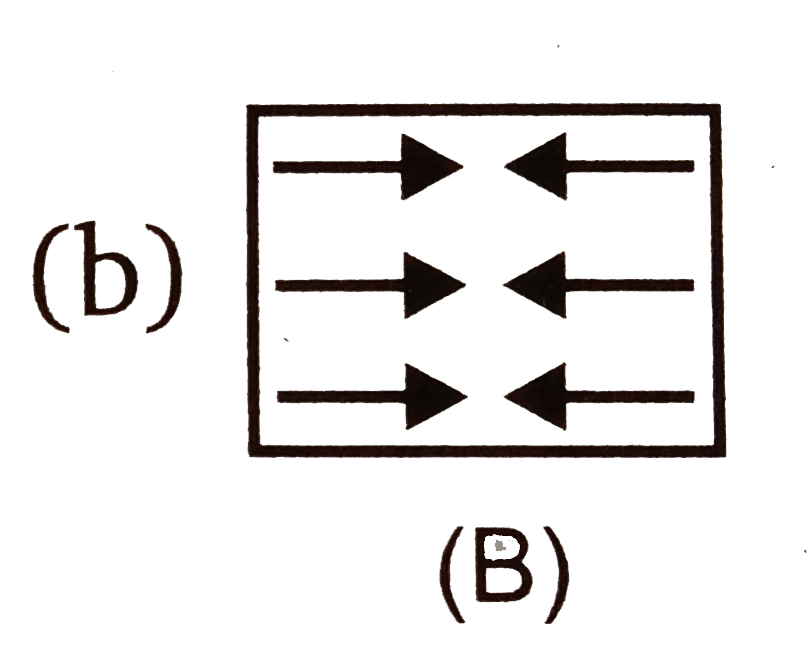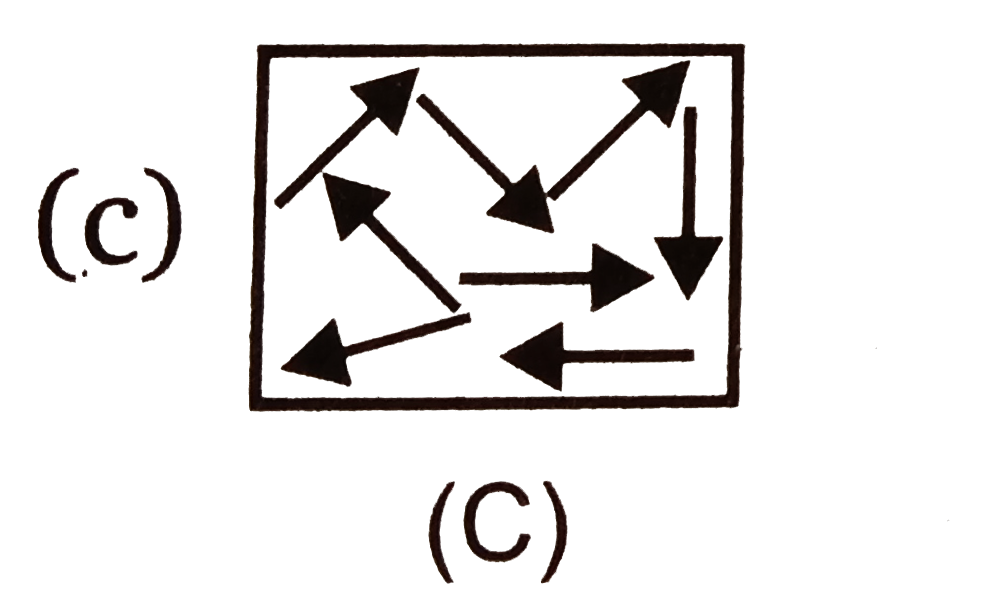A: In a diamagnetic substance each atom has a non-zero dipole moment but due to thermal agitation the individual dipoles ramein randomly oriented and, therefore, the net dipole moment in any finite volume of the substance remains zero.
R: On increasing the temperature the magnetism inside a perament magent increases.
If both Assertion & Reason are the true and the reason is the correct explanation of the assertion, then mark (1)
If both Assertion & Reason are true but the reson is not the correct explanation of the assertion, then mark (2)
If Assertion is true statement but Reason is false, then mark (3)
If both Assertion and Reason are false statements, then mark (4)
The correct Answer is:D
To solve the question, we need to analyze both the assertion (A) and the reason (R) provided in the statement.
Step 1: Understand the Assertion (A)
The assertion states that in a diamagnetic substance, each atom has a non-zero dipole moment, but due to thermal agitation, the individual dipoles remain randomly oriented, resulting in a net dipole moment of zero in any finite volume of the substance.
Explanation:
- Diamagnetic substances are characterized by having all their electrons paired. When electrons are paired, their magnetic moments cancel each other out, leading to a net magnetic moment of zero for each atom.
- The statement that each atom has a non-zero dipole moment is incorrect because, in diamagnetic materials, the paired electrons result in zero net dipole moment.
Step 2: Understand the Reason (R)
The reason states that on increasing the temperature, the magnetism inside a permanent magnet increases.
Explanation:
- In permanent magnets, the magnetic domains are aligned, giving them a net magnetic moment.
- However, increasing the temperature increases thermal agitation, which can disrupt the alignment of these magnetic domains, leading to a decrease in magnetism. Therefore, this statement is also incorrect.
Step 3: Conclusion
Since both the assertion (A) and the reason (R) are incorrect, the answer to the question is that both statements are false.
Final Answer:
Both A and R are incorrect.
---
The assertion states that in a diamagnetic substance, each atom has a non-zero dipole moment, but due to thermal agitation, the individual dipoles remain randomly oriented, resulting in a net dipole moment of zero in any finite volume of the substance.
- Diamagnetic substances are characterized by having all their electrons paired. When electrons are paired, their magnetic moments cancel each other out, leading to a net magnetic moment of zero for each atom.
- The statement that each atom has a non-zero dipole moment is incorrect because, in diamagnetic materials, the paired electrons result in zero net dipole moment.
The reason states that on increasing the temperature, the magnetism inside a permanent magnet increases.
- In permanent magnets, the magnetic domains are aligned, giving them a net magnetic moment.
- However, increasing the temperature increases thermal agitation, which can disrupt the alignment of these magnetic domains, leading to a decrease in magnetism. Therefore, this statement is also incorrect.
Since both the assertion (A) and the reason (R) are incorrect, the answer to the question is that both statements are false.
Both A and R are incorrect.
Topper's Solved these Questions
- MAGNETISM AND MATTER BOOK - AAKASH INSTITUTECHAPTER - MAGNETISM AND MATTER EXERCISE - ASSIGNMENT (SECTION C)
31 Videos
- LAWS OF MOTIONBOOK - AAKASH INSTITUTECHAPTER - LAWS OF MOTIONEXERCISE - Assignment (SECTION-D) (Assertion-Reason Type Questions)
15 Videos
- MECHANICAL PROPERTIES OF FLUIDSBOOK - AAKASH INSTITUTECHAPTER - MECHANICAL PROPERTIES OF FLUIDSEXERCISE - SECTION - J
9 Videos
Similar Questions
Polar covalent molecules exhibit dipole moment. Dipole moment is equal to the product of charge separation , q and the bond length d for the bond. Unit of dipole moment is debye. One debye is equal to 10−18 esu cm.
Dipole moments is a vector quantity. It has both magnitude and direction. Hence, dipole moment of a molecule depends upon the relative orientation of the bond dipoles, but not on the polarity of bonds alone. A symmetrical structure shows zero dipole moment. Thus, dipole moment helps to predict the geometry of a molecules. Dipole moment values can be distinguish between cis- and trans- isomers, ortho, meta and pare-forms of a substance, etc.
Q. Which is a polar molecule?
View SolutionPolar covalent molecules exhibit dipole moment. Dipole moment is equal to the product of charge separation , q and the bond length d for the bond. Unit of dipole moment is debye. One debye is equal to 10−18 esu cm.
Dipole moments is a vector quantity. It has both magnitude and direction. Hence, dipole moment of a molecule depends upon the relative orientation of the bond dipoles, but not on the polarity of bonds alone. A symmetrical structure shows zero dipole moment. Thus, dipole moment helps to predict the geometry of a molecules. Dipole moment values can be distinguish between cis- and trans- isomers, ortho, meta and pare-forms of a substance, etc.
Q. A diatomic molecule has a dipole moment of 1.2D. If the bond length is 1.0×10−8 cm, what fraction of charge does exist each atom?
View Solution
Knowledge Check
Paramagnetic substances are those, in which the individual atoms, ions or molecules posses a permanent magnetic dipole moment. In the absence of an external magnetic field, the atomic dipoles of paramagentic substance are as below:
A B
B C
C D
D
Assertion: In the absence of an external electric field, the dipole moment per unit volume of a polar dielectric is zero.
Reason : The dipoles of a polar dielectric are randomly oriented.AAssertion is correct, reason is correct, reason is a correct explanation for assertion.BAssertion is correct, reason is correct, reason is not a correct explanation for assertionCAssertion is correct, reason is incorrectDAssertion is incorrect, reason is correctWhich of the following substancs has dipole moment more than zero ?
AWaterBMethaneCCarbon dioxideDNitrogen
Polar covalent molecules exhibit dipole moment. Dipole moment is equal to the product of charge separation , q and the bond length d for the bond. Unit of dipole moment is debye. One debye is equal to 10−18 esu cm.
Dipole moments is a vector quantity. It has both magnitude and direction. Hence, dipole moment of a molecule depends upon the relative orientation of the bond dipoles, but not on the polarity of bonds alone. A symmetrical structure shows zero dipole moment. Thus, dipole moment helps to predict the geometry of a molecules. Dipole moment values can be distinguish between cis- and trans- isomers, ortho, meta and pare-forms of a substance, etc.
Q. Arrange the following compounds in increasing order of dipole moments, toluene (I), o-dichlorobenzene (II), m-dichlorobenzene (III) and p-dichlorobenzene (IV) :
View SolutionPolar covalent molecules exhibit dipole moment. Dipole moment is equal to the product of charge separation , q and the bond length d for the bond. Unit of dipole moment is debye. One debye is equal to 10−18 esu cm.
Dipole moments is a vector quantity. It has both magnitude and direction. Hence, dipole moment of a molecule depends upon the relative orientation of the bond dipoles, but not on the polarity of bonds alone. A symmetrical structure shows zero dipole moment. Thus, dipole moment helps to predict the geometry of a molecules. Dipole moment values can be distinguish between cis- and trans- isomers, ortho, meta and pare-forms of a substance, etc.
Q. Arrange the following compounds in increasing order of dipole moments, toluene (I), o-dichlorobenzene (II), m-dichlorobenzene (III) and p-dichlorobenzene (IV) :
View SolutionPolar covalent molecules exhibit dipole moment. Dipole moment is equal to the product of charge separation, q and the bond length d for the bond. Unit of dipole moment is Debye. One Debye is equal to 10−18 esu-cm.
Dipole moment is a vector quantity. It has both magnitude and direction. Hence, dipole moment of a molecule depends upon the relative orientation of the bond dipoles, but not on the polarity of bonds alone. A symmetrical structure shows zero dipole moment. Thus, dipole moment helps to predict the geometry of a molecules. Dipole moment values can be used to disinguisd between cis- and trans- isomers, ortho-, meta - and para - forms of a substance, etc.
Among the following, which is a type of non-planar as well as non-polar compound?
View SolutionPolar covalent molecules exhibit dipole moment. Dipole moment is equal to the product of charge separation , q and the bond length d for the bond. Unit of dipole moment is debye. One debye is equal to 10−18 esu cm.
Dipole moments is a vector quantity. It has both magnitude and direction. Hence, dipole moment of a molecule depends upon the relative orientation of the bond dipoles, but not on the polarity of bonds alone. A symmetrical structure shows zero dipole moment. Thus, dipole moment helps to predict the geometry of a molecules. Dipole moment values can be distinguish between cis- and trans- isomers, ortho, meta and pare-forms of a substance, etc.
Q. μ of the AX4 type of molecule is zero. The geometry of it can be :
View SolutionPolar covalent molecules exhibit dipole moment. Dipole moment is equal to the product of charge separation , q and the bond length d for the bond. Unit of dipole moment is debye. One debye is equal to 10−18 esu cm.
Dipole moments is a vector quantity. It has both magnitude and direction. Hence, dipole moment of a molecule depends upon the relative orientation of the bond dipoles, but not on the polarity of bonds alone. A symmetrical structure shows zero dipole moment. Thus, dipole moment helps to predict the geometry of a molecules. Dipole moment values can be distinguish between cis- and trans- isomers, ortho, meta and pare-forms of a substance, etc.
Q. μ of the AX4 type of molecule is zero. The geometry of it can be :
View Solution
